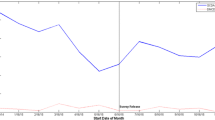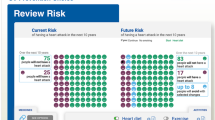Abstract
Background
Effective shared decision-making (SDM) tools for use during clinical encounters are available, but, outside of study settings, little is known about clinician use of these tools in practice.
Objective
To describe real-world use of an SDM encounter tool for statin prescribing, Statin Choice, embedded into the workflow of an electronic health record.
Design
Cross-sectional study.
Participants
Clinicians and their statin-eligible patients who had outpatient encounters between January 2020 and June 2021 in Cleveland Clinic Health System.
Main Measures
Clinician use of Statin Choice was recorded within the Epic record system. We categorized each patient’s 10-year atherosclerotic cardiovascular disease risk into low (< 5%), borderline (5–7.5%), intermediate (7.5–20%), and high (≥ 20%). Other patient factors included age, sex, insurance, and race. We used mixed effects logistic regression to assess the odds of using Statin Choice for statin-eligible patients, accounting for clustering by clinician and site. We generated a residual intraclass correlation coefficient (ICC) to characterize the impact of the clinician on Statin Choice use.
Key Results
Statin Choice was used in 7% of 68,505 eligible patients. Of 1047 clinicians, 48% used Statin Choice with ≥ 1 patient, and these clinicians used it with a median 9% of their patients (interquartile range: 3–22%). In the mixed effects logistic regression model, patient age (adjusted OR per year: 1.04; 95%CI 1.03–1.04) and 10-year ASVCD risk (aOR for 5–7.5% versus < 5% risk: 1.28; 95%CI: 1.14–1.44) were associated with use of Statin Choice. Black versus White race was associated with a lower odds of Statin Choice use (aOR: 0.83; 95%CI: 0.73–0.95), as was female versus male sex (aOR: 0.83; 95%CI: 0.76–0.90). The model ICC demonstrated that 53% of the variation in use of Statin Choice was clinician-driven.
Conclusions
Patient factors, including race and sex, were associated with clinician use of Statin Choice; half the variation in use was attributable to individual clinicians.


Similar content being viewed by others
References
Montori VM, Kunneman M, Brito JP. Shared decision making and improving health care: The answer is not in. JAMA. 2017;318:617-618.
Kunneman M, Griffioen IPM, Labrie NHM, Kristiansen M, Montori VM, van Beusekom MM. Making care fit manifesto. BMJ Evid Based Med. 2023;28:5-6.
Stacey D, Légaré F, Col NF, et al. Decision aids for people facing health treatment or screening decisions. Cochrane Database Syst Rev. 2014;1:CD001431.
Kuo AMS, Thavalathil B, Elwyn G, Nemeth Z, Dang S. The promise of electronic health records to promote shared decision making: a narrative review and a look ahead. Med Decis Making. 2018;38:1040-1045.
Stacey D, Suwalska V, Boland L, Lewis KB, Presseau J, Thomson R. Are patient decision aids used in clinical practice after rigorous evaluation? A survey of trial authors. Med Decis Making. 2019;39:805-815.
Weymiller AJ, Montori VM, Jones LA, et al. Helping patients with type 2 diabetes mellitus make treatment decisions. Arch Intern Med. 2007;167:1076.
Heidenreich PA, Estes NAM, Fonarow GC, et al. 2020 update to the 2016 ACC/AHA clinical performance and quality measures for adults with atrial fibrillation or atrial flutter: a report of the American College of Cardiology/American Heart Association task force on performance measures. J Am Coll Cardiol. 2021;77:326-341.
Mann DM, Ponieman D, Montori VM, Arciniega J, McGinn T. The statin choice decision aid in primary care: a randomized trial. Patient Educ Couns. 2010;80(1):138-140.
Arnett DK, Blumenthal RS, Albert MA, et al. 2019 ACC/AHA guideline on the primary prevention of cardiovascular disease: executive summary: a report of the American College of Cardiology/American Heart Association task force on clinical practice guidelines. J Am Coll Cardiol. 2019;74:1376-1414.
Inselman J, Branda M, Castaneda-Guarderas A, et al. Uptake and documentation of the use of an encounter decision aid in usual practice: a retrospective analysis of the use of the statin/aspirin choice decision aid. Med Decis Making. 2015;36:557-561.
Cooper-Patrick L, Gallo J, Gonzales J, et al. Race, gender, and partnership in the patient-physician relationship. JAMA. 1999;282:583-589.
Ratanawongsa N, Zikmund-Fisher BJ, Couper MP, Van Hoewyk J, Powe NR. Race, ethnicity, and shared decision making for hyperlipidemia and hypertension treatment: the decisions survey. Med Decis Making. 2010;30:65-76.
Lewey J, Shrank WH, Bowry ADK, Kilabuk E, Brennan TA, Choudhry NK. Gender and racial disparities in adherence to statin therapy: A meta-analysis. Am Heart J. 2013;165:665-678.e1.
Jacobs JA, Addo DK, Zheutlin AR, et al. Prevalence of statin use for primary prevention of atherosclerotic cardiovascular disease by race, ethnicity, and 10-year disease risk in the us: national health and nutrition examination surveys, 2013 to March 2020. JAMA Cardiol. 2023;8:443-452.
Rodriguez F, Maron DJ, Knowles JW, Virani SS, Lin S, Heidenreich PA. Association of statin adherence with mortality in patients with atherosclerotic cardiovascular disease. JAMA Cardiol. 2019;4:206.
Nathan AG, Marshall IM, Cooper JM, Huang ES. Use of decision aids with minority patients: a systematic review. J Gen Intern Med. 2016;31:663-676.
Ben-Zacharia A, Adamson M, Boyd A, et al. Impact of shared decision making on disease-modifying drug adherence in multiple sclerosis. Int J MS Care. 2018;20:287-297.
Fiorillo A, Barlati S, Bellomo A, et al. The role of shared decision-making in improving adherence to pharmacological treatments in patients with schizophrenia: a clinical review. Ann Gen Psychiatry. 2020;19:43.
Dorsch MP, Lester CA, Ding Y, Joseph M, Brook RD. Effects of race on statin prescribing for primary prevention with high atherosclerotic cardiovascular disease risk in a large healthcare system. J Am Heart Assoc. 2019;8:e014709.
Nanna MG, Wang TY, Xiang Q, et al. Sex differences in the use of statins in community practice. Circ Cardiovasc Qual Outcomes. 2019;12:e005562.
Abadie R, Weymiller AJ, Tilburt J, et al. Clinician’s use of the statin choice decision aid in patients with diabetes: a videographic study nested in a randomized trial. J Eval Clin Pract. 2009;15:492-497.
Ballard AY, Kessler M, Scheitel M, Montori VM, Chaudhry R. Exploring differences in the use of the statin choice decision aid and diabetes medication choice decision aid in primary care. BMC Med Inform Decis Mak. 2017;17:118.
Brace C, Schmocker S, Huang H, Victor JC, McLeod RS, Kennedy ED. Physicians’ awareness and attitudes toward decision aids for patients with cancer. J Clin Oncol. 2010;28:2286-2292.
Rotenstein LS, Apathy N, Edgman-Levitan S, Landon B. Comparison of work patterns between physicians and advanced practice practitioners in primary care and specialty practice settings. JAMA Netw Open. 2023;6:e2318061.
Mangione CM, Barry MJ, Nicholson WK, et al. Statin use for the primary prevention of cardiovascular disease in adults: us preventive services task force recommendation statement. JAMA. 2022;328:746-753.
Brodney S, Valentine K, Sepucha KR, Fowler FJ, Barry MJ. Patient preference distribution for taking a statin. JAMA Netw Open. 2021;4:e210661.
Valentine K, Brodney S, Sepucha K, Barry MJ. Predictors of informed people’s preferences for statin therapy to reduce cardiovascular disease risk: an internet survey study. J Gen Intern Med. 2023;38:36-41.
Brodney S, Valentine KD, Sepucha K, Fowler FJ, Barry MJ. Patient preference distribution for use of statin therapy. JAMA Netw Open. 2021;4:e210661.
Coylewright M, Keevil JG, Xu K, Dodge SE, Frosch D, Field ME. Pragmatic study of clinician use of a personalized patient decision aid integrated into the electronic health record: An 8-year experience. Telemed J E Health. 2020;26:597-602.
Patel MS, Volpp KG, Asch DA. Nudge units to improve the delivery of health care. N Engl J Med. 2018;378:214-216.
Elias P, Peterson E, Wachter B, Ward C, Poon E, Navar AM. Evaluating the impact of interruptive alerts within a health system: use, response time, and cumulative time burden. Appl Clin Inform. 2019;10:909-917.
Author information
Authors and Affiliations
Corresponding author
Ethics declarations
Conflict of Interest:
The authors declare that they do not have a conflict of interest.
Additional information
Publisher's Note
Springer Nature remains neutral with regard to jurisdictional claims in published maps and institutional affiliations.
Rights and permissions
Springer Nature or its licensor (e.g. a society or other partner) holds exclusive rights to this article under a publishing agreement with the author(s) or other rightsholder(s); author self-archiving of the accepted manuscript version of this article is solely governed by the terms of such publishing agreement and applicable law.
About this article
Cite this article
Martinez, K.A., Montori, V.M., Rodriguez, F. et al. Clinician use of the Statin Choice Shared Decision-making Encounter Tool in a Major Health System. J GEN INTERN MED (2024). https://doi.org/10.1007/s11606-023-08597-3
Received:
Accepted:
Published:
DOI: https://doi.org/10.1007/s11606-023-08597-3




